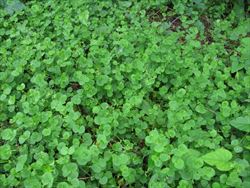Tropical chickweed; it is also known as heartleaf drymary, whitesnow, West Indian chickweed.
Pacific Pests, Pathogens, Weeds & Pesticides - Online edition
Pacific Pests, Pathogens, Weeds & Pesticides
Tropical chickweed (510)
Drymaria cordata. It is a member of the Caryophyllaceae.
Asia, Africa, North, South and Central America, the Caribbean, Oceania. It is recorded from Australia, Fiji, French Polynesia, New Caledonia, Papua New Guinea. It is considered to have originated in tropical America.
An aggressive, creeping weed of plantation, root, and vegetable crops, pastures, lawns, roadsides, riverbanks, secondary forests and forest margins in tropical and sub-tropical countries. Said to be one of the most invasive plants. It tolerates a range of soil types, but prefers moist shady sites. Seed production, seedling development and vegetative growth are rapid, resulting in the smothering of other plants and the colonisation of large areas (Photos 1&2). Tropical chickweed occurs from the lowlands to 2000 masl.
Tropical chickweed has smooth weak creeping stems up to 1 m long that branch frequently and often root at the nodes (Photo 3). The leaves are round or heart-shaped, in opposite pairs, on short stalks (3-10 mm), with three to five veins (Photo 3). Flowers, white, on stalks, 3-5 mm long, at the forked end of the stems or arising from the axils of the leaves (between leaf and stem) (Photos 4&5). The five petals are white, deeply lobed (so deep that it looks like 10) (Photo 5). Beneath them are five leaf-like structures, the sepals. The fruit is dark-brown, 2-3 mm diameter, with 5 to 10 somewhat flat seeds.
Spread is mostly by seed via wind and water, and vegetatively via roots formed at nodes on the stems. Both seed and vegetative material spread as contaminants of hay, and on vehicles. Deliberate introduction for medicinal use occurs. There is also a possibility for transfer of seed on animal fur.
Tropical chickweed has economic and environmental impacts. CABI says it is a weed of more than 30 crops in more than 45 countries. However, the costs on production are not well documented. Environmental impacts concern the effect on native vegetation which can be destroyed by the weed. In Sri Lanka, it has been tried as a ground-cover in tea, but yields were reduced.
The leaves and young shoots are eaten, usually raw in salads, but also cooked as a vegetable. It is also used in traditional medicines for treating respiratory ailments and bronchitis, although in the treatment of many other conditions have been recorded. It is said to be a useful fodder for livestock, although there are other accounts suggesting it is potentially poisonous to cattle. In India, it has been used as a ground cover to stop soil erosion. In the Caribbean, it is reported as a ground cover in banana plantations because of its ability to tolerate shade, and to compete successfully with other weeds.
BIOSECURITY
Drymaria cordata has a very wide distribution, so countries not yet infested are very vulnerable to its introduction. Consequently, they should consider all likely pathways for entry, and apply quarantine measures accordingly. Particular attention should be given to the likelihood that seed of tropical chickweed could be a contaminant of the seed of other crop species. Its presence in fodder should also be considered. Additionally, this plant is widely used in traditional medicines and the fact that seed could be sent across international borders is a concern. Seed is available for purchase on the Internet.
BIOLOGICAL CONTROL
No information available.
CULTURAL CONTROL
- Physical & Mechanical:
- Hand weeding (and hoeing) is effective on small areas where follow-up is possible to control seedlings.
- Slashing will slow growth, but not prevent it; note, stems pieces will root and form new plants.
- Cultivation effective in dry season in pastures, but regeneration occurs in wet, without vigorous growth of grass and legume.
- Mulch:
- Maintain a layer of mulch. The seeds are small and seedlings will have difficulty penetrating a 5-10 cm layer of mulch.
- Hygiene:
- Treat vehicles and farm machinery. If moving from areas where the weed occurs to those weed-free, wash to remove soil and seed. This is equally important if the machinery is being imported into a country or moved within a country.
- Fodder:
- Make sure hay brought into clean areas is free of tropical chickweed.
CHEMICAL CONTROL
In Australia, several herbicides are allowed under minor use permits for use in vegetable crops for the control of chickweeds (https://apvma.gov.au/), including: napropamide; cyanazine; dicamba; metribuzin; oxyfluorfen; terbutryn. In Fiji, glyphosate; dicamba and 2,4-D are recommended.
--------------------
Note, EU approval to use glyphosate ends in December 2022; its use after that date is under discussion.
____________________
When using a pesticide, always wear protective clothing and follow the instructions on the product label, such as dosage, timing of application, and pre-harvest interval. Recommendations will vary with the crop and system of cultivation. Expert advice on the most appropriate herbicides to use should always be sought from local agricultural authorities.
AUTHORS Grahame Jackson & Makereta Ranadi
Information from CABI (2019) Drymaria cordata (tropical chickweed). Crop Protection Compendium. (https://www.cabi.org/cpc/datasheet/20020); Fern K (2021) Tropical Plants Database (http://tropical.theferns.info/viewtropical.php?id=Drymaria+cordata); and Eat the weeds (http://www.eattheweeds.com/drymaria-cordata-kissing-cousin-chickweed-2/); and from West Indian chickweed - Drymaria cordata. (http://www.it2.fr/wp-content/uploads/2014/11/DOC_IT2_2014-Fiche-manuel-BGM-n11-Petit-mouron_ANG_BD1.pdf). Photo 1 Harry Rose, South West Rocks, Australia. (https://en.wikipedia.org/wiki/Drymaria_cordata#/media/File:Drymaria_cordata_flower1_(13835011814).jpg). Photo 2 Krish Dulal. Uprooted Drymaria cordata found in Panchkhal Valley, Nepal. Wikimedia Commons. (https://commons.wikimedia.org/wiki/File:Drymaria_cordata_02.JPG). Photo 3 Forest and Kim Starr. Starr Environmental. The low mats of growth make a good ground cover. (http://tropical.theferns.info/plantimages/a/d/ad8f08750edc9898bc9c29464b50d7048ba06276.jpg). Photo 4 Harry Rose. The plant can form extensive mats of growth. (http://tropical.theferns.info/plantimages/6/f/6f89a569623a0df6abb044812b59e2077c985cff.jpg). Photo 5 O.M. Montiel. Close up of small flowers. (http://tropical.theferns.info/plantimages/8/0/804851ac2483c6c841fe5f45b886f5b1755fce2a.jpg)
Produced with support from the Australian Centre for International Agricultural Research under project HORT/2016/185: Responding to emerging pest and disease threats to horticulture in the Pacific islands, implemented by the University of Queensland, in association with the Pacific Community and Koronivia Research Station, Ministry of Agriculture, Fiji.








